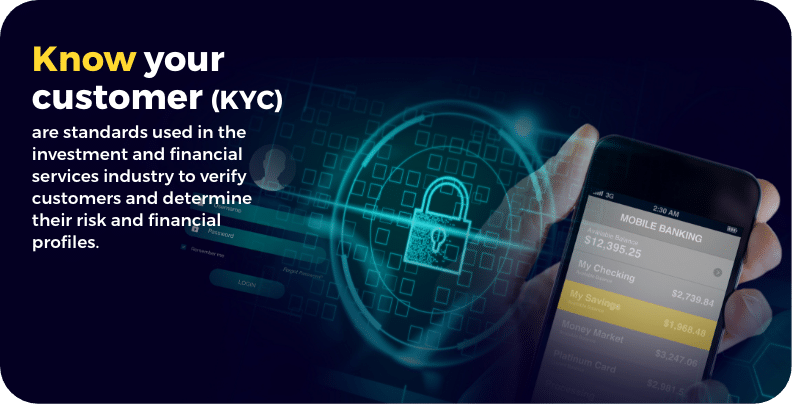Do you really know your customers? Do you have an accurate, efficient way to verify their identities before granting them access to your products, services, and systems architecture? How much does it cost you to achieve that?
The expansion of digital economies and the evolution of cyber security threats make these questions more important than ever. Here, we will discuss the meaning of KYC and its importance. We’ll also consider 6 ways to better know your customer identification program to protect your interests and those of your customers.

What is KYC and how does it work?
Know Your Customer (KYC), also called Know Your Client, is a set of regulatory standards to which investments, financial services, businesses, and organizations are held accountable.
The purpose of KYC Software is, first and foremost, to identify and verify the client and customer identity, plus their financial and fraud-risk profiles.
KYC verification starts from the moment users, customers, and clients attempt to open an account to perform any financial transactions.
After initial KYC verification, re-verification can also apply at specific points in the customer journey as part of the KYC-regulated entity’s identity management processes.
This re-verification process ensures that the attempted use of the originally-verified account and user identity remains consistent with the identity of the originally-verified user.
It also prevents cybercriminals and other bad actors from accessing and compromising customer accounts for fraud and data theft.
What are the steps of a KYC Compliance Program?
KYC identity verification starts with identifying who your customer is. To do this, the KYC-regulated party must verify customers’ digital and physical identities.
This personally identifiable information (PI) can include:
- Names
- Date of birth
- Address
- Identification number – i.e., social security number
- Facial biometrics and physical features
- Compliance with KYC regulations is non-negotiable.
Exact policies may differ, depending on a variety of factors. These factors include the size and location of an institution, the types of accounts it uses, the methods of opening those accounts, and the information available for identification.
Institutions often verify these credentials through ID and other documents or by comparing them to information shared by consumer reporting agencies, public government databases, or other measures.
What comes next?
Verifying a customer’s identity is just the first step.
Once this is done, institutions must do due diligence to manage risk and determine if a potential customer is trustworthy.
There are three levels of due diligence, stratified according to risk:
Simplified Due Diligence
This refers to situations where the risk of financial crime, money laundering, or terrorist funding is considered low. As a result, there’s no need to investigate further.
Essential Customer Due Diligence (CDD)
Where there is a possibility of risk, organizations need to assess the nature and extent of that risk. To do this, they collect more information about the customer. This may include deeper digital identity verification or information about the customer’s business activities.
Enhanced Due Diligence (EDD)
For higher-risk clients, it’s necessary to go further. An institution will collect more detailed information about the customer’s business activity, market engagement, and even associated entities as part of EDD.
The final step in a KYC program consists of ongoing monitoring for irregularities. These include spikes in activity, adverse media mentions, unusual location behaviors, and more. The level of continuing monitoring depends on the institution’s risk assessment of its client.
Why is KYC important?
KYC verification standards protect institutions and customers from various potential risks. For customers, KYC standards help to fight and prevent identity theft and other financial fraud that bad actors may try to commit in their name. For an institution, KYC standards help mitigate the risks of money laundering, financing of terrorism, and other forms of financial crimes that harm the institution, its customers, and its country. Failure to comply can also lead to heavy penalties for these institutions. Across the world, the adoption of KYC regulations is leading to greater transparency and better outcomes for all.
KYC vs. AML
The phrases Know Your Customer (KYC) and Anti-Money Laundering (AML) often occur together. In fact, they’re often used interchangeably, as if they mean the same thing. While they are closely related, it’s essential to distinguish between them. The critical difference is that AML is a broad policy framework that includes a variety of regulations, policies, and techniques, one of which is KYC.
The AML framework aims to detect and prevent financial crimes such as money laundering, tax evasion, and the financing of terrorist organizations. AML screening is one of the mechanisms that enables institutions to mitigate risks and detect fraudulent activity. AML screening software is designed to determine whether the customer is linked to negative media or is subject to any bans or sanctions. These factors are essential elements of overall fraud risk assessment.
KYC within AML
But before AML screening, you need robust KYC processes to ensure you know who you’re dealing with. KYC uses the Personally identifiable information (PII) of humans interacting with a system to verify that they are who they say they are. For this reason, KYC is usually the first step in an organization’s AML process. Once you know your customers and are confident that their identities are genuine, you can adequately assess the risk you’re exposed to and implement further AML measures.
How Often Should KYC be Updated?
But KYC can only provide that foundation if it keeps up with changes in customers’ lives. Some of your customers’ PII, such as addresses, contact numbers, or document numbers, can change. More importantly, risk profiles can change drastically over time. Institutions must also remain compliant when KYC regulations evolve to adapt to new forms of commerce.
As a result, knowing your customer continues after Digital onboarding. It continues with ongoing monitoring, also known as KYC remediation. This involves bringing customer data up to date regularly.
The exact frequency varies, but the higher the risk, the more often this needs to happen. As a general rule, remediation should occur every 6 to 36 months.
What Does KYC Monitoring Look For?
The customer’s risk profile determines the exact parameters of the monitoring process. For higher-risk customers, monitoring takes a variety of factors into account. They include, but aren’t limited to:
- Adverse media
- Sanction lists
- Erratic behavior or sudden changes in activity
- Transnational activity
When such issues are flagged, the bank or institution may file a Suspicious Activity Report (SAR) to make necessary adjustments.
How do KYC standards help prevent identity theft, money laundering, and financial fraud?
It’s impossible to prevent all the nefarious activity out there completely. But KYC standards provide institutions and their customers with safeguards against ever-present risks. Verifying customer identities and assessing the risk of their activities is essential to the institution-customer relationship. In addition, a detailed understanding of their customers’ identities and activities enables institutions to determine their validity, ultimately protecting both parties.
Gaining the edge over financial crime does come with a cost, however. LexisNexis’ Global True Cost of Compliance 2020 report showed that financial institutions spent significantly more on financial crime compliance in 2020 than in previous years – as much as $213.9 billion.
What is KYC in the context of onboarding?
KYC for onboarding accounted for a large part of this cost, especially in Asia. In the future, financial institutions will need to optimize KYC processes at the lowest possible price.
So, what is KYC in practice when faced with rising compliance costs? Here are some ways that KYC processes can adapt to meet this challenge. 6 tips that will help you to know your customer better
Improving KYC processes means balancing technology and human resources to minimize cost without compromising quality.
Embrace automation intelligently
Many processes can be automated in collecting and analyzing customer data. That means you can only partially eliminate human input and the time cost it brings. But it does mean less redundancy and less error.
Focus on data quality
Your KYC process is only as good as the underlying data collection. Problems with data quality may account for over a quarter of operational costs. There are several steps you can take to ensure your data is correct, complete, and timely:
- Data quality review by a third-party
- Implement strict oversight of all manual processes
- Incorporate adverse media data into screening
- Monitoring and remediation
KYC verification and onboarding are the beginning, not the end. Existing KYC data needs to be refreshed to ensure its accuracy and completeness. New information must be incorporated, whether from media or changes in a customer’s behavior and risk profile.
Create solid due diligence checklists
Customers call for different types of due diligence: individuals, businesses, high-risk, and low-risk. Accurate risk assessment helps institutions to allocate resources appropriately and develop more detailed profiles.
Use electronic identity verification
In a digital age, electronic identity verification is simply non-negotiable. Identity verification software makes identity theft much more difficult. It also helps institutions to scale operations while simultaneously reducing labor. In addition, quicker turnaround times lead to greater customer satisfaction. Crucially, the identity verification tools of the future are fully automated, with no human input.
Provide exemplary customer experiences
Customers know that KYC regulations are necessary. But you should avoid frustrating them with lengthy, complex procedures. Simplicity is key to successful onboarding. Ensure your process is well-structured, straightforward, and easy to understand, even for people needing more technical skills.
As customers raise their standards and expectations, businesses need to keep up. Compliance teams can learn about creating friction-free journeys from Customer Relationship Management (CRM).
Book a Demo
Give your business the boost of a fully automated KYC process. No geographical limitsand fast, frictionless onboarding verification processes enhance customer experience.
FAQs
What are the requirements for KYC compliance?
KYC compliance typically involves verifying personal information, including names, dates of birth, addresses, and identification numbers. The exact process may vary based on the institution and the level of risk associated with the customer.
What is KYC Standards for Banks?
KYC standards for banks encompass the procedures and policies banks must follow to identify and verify their customers. These standards are essential to prevent money laundering and other financial crimes.
What Are the 4 Stages of Customer Due Diligence?
The four stages of customer due diligence include Simplified Due Diligence (SDD), Basic Customer Due Diligence (CDD), Enhanced Due Diligence (EDD), and Ongoing Monitoring. These stages help institutions assess customer risk levels and ensure compliance.
What is the KYC Process in the US?
The KYC process in the United States follows regulatory guidelines set by various agencies, including the Financial Crimes Enforcement Network (FinCEN). It involves verifying customer identities and assessing risk levels.
What is the KYC Process in the UK?
In the United Kingdom, the KYC process is regulated by the Financial Conduct Authority (FCA) and involves similar procedures to verify customer identities and manage risk effectively.







